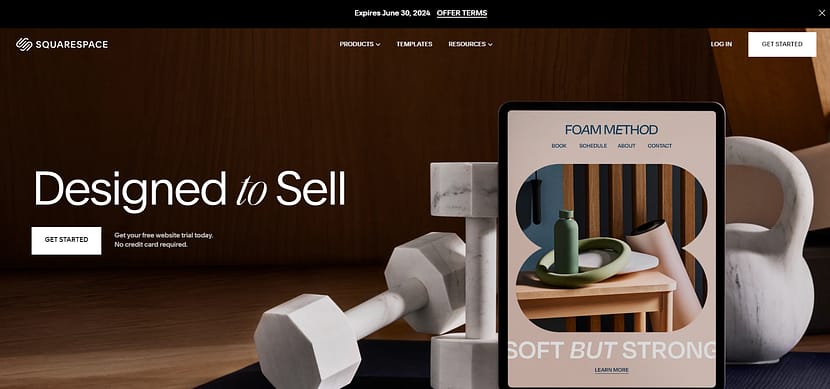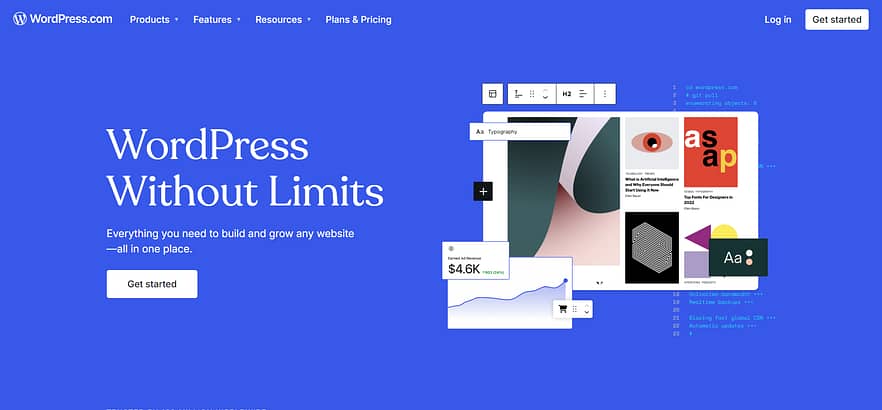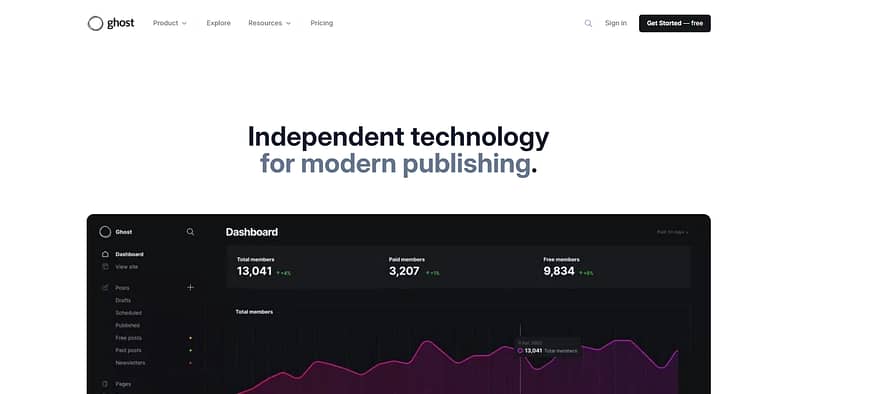TL;DR: Best Blog Platforms (The Short Version)
If you’re short on time, here’s the quick rundown:
After testing and migrating between multiple blogging platforms over the years, my top recommendation is WordPress.org. It gives you complete control, room to grow, and the freedom to monetize your content however you choose.
That said, not everyone needs the same setup.
- Wix and Squarespace are great if you want a visually polished site without the tech headaches. But you don't own your platform fully.
- Medium and Ghost are perfect for writers who want to focus purely on content (and, in Ghost’s case, monetize through memberships). Medium has low design flexibility, Ghost requires a bit of learning.
- WordPress.com and Weebly are ideal for hobbyists or beginners who just want a space to write.
- HubSpot makes sense for businesses that want blogging tied directly to marketing and CRM tools.
And because the creator economy keeps evolving, I’ve also included two rising platforms — Substack and Beehiiv — for writers and newsletter creators who want to grow their audience and earn directly from readers.
Bottom line?
Choose the platform that fits where you are now, but also one that won’t limit you when you’re ready to grow.
When I started my first blog in 2012, I had no idea what to look for in a blogging platform. I found the easiest tool to work with (that was also free) and got started.
While I'm grateful for taking the leap into blogging (I wouldn't be here without it), I do wish I knew then what I know now. Many years and several platform migrations later -- each one more tiring than the last -- I've learned exactly what matters when choosing where to build your blog.
This guide is different. I've had experience with each platform I discuss here and have focused on what actually impacts your daily blogging life.
Your choice comes down to three simple questions:
- What do you need right now?
- What will you need in a year?
- What can you actually afford?
By the end of this guide, you'll know your perfect match.
Why Trust This Guide?
Hi! I'm Chipo and I'm a marketer with 7+ years experience in marketing and all things WordPress.
Over the years, I’ve worked with Thrive Themes tools to design high-performing sites that convert — so I know exactly what matters when you’re choosing where to build your blog, and what will come back to bite you later.
This guide isn’t theoretical or AI-generated fluff — it’s based on real, hands-on experience, countless migrations, and the lessons I wish I’d known before I started.
Key Takeaways
- WordPress.org offers the most long-term flexibility and control for bloggers who want to build, scale, and monetize a content-driven business.
- Wix and Squarespace work best for beginners who prioritize ease of use and polished design over full ownership and customization.
- Substack and Beehiiv are the leading platforms for writers focused on paid newsletters and direct audience monetization.
- Hostinger Website Builder is a low-cost, beginner-friendly option for getting online quickly, but it is not built for long-term scaling.
- LinkedIn functions best as a professional publishing and distribution platform, not a standalone blog, and works strongest alongside a site you own.
How I Picked These 12 Best Blogging Platforms
When I started blogging, I made the classic beginner's mistake: I chose a platform based solely on its free plan and basic customization options. As my blog grew, my needs changed dramatically. I found myself migrating between platforms—a process that's about as fun as moving apartments. Three platform switches later, I've learned what really matters when choosing a blogging home.
To save you from the same platform-hopping headache, I've created a careful selection process based on real blogging growth. Here's what I specifically looked for:
My goal was to find platforms that work well for different types of bloggers, from hobby writers to business owners, without getting caught up in flashy features that rarely get used. The right choice depends on where you are now—and where you plan to be in a few years.
Choosing a Blogging Platform for Monetization
If the goal is to turn a blog into an income-generating asset, the platform matters as much as the content.
Quick Glance: My Top Blogging Platform Picks
If you’re the kind of person who likes to see the big picture before diving into details, here’s a quick snapshot of how the top blogging platforms stack up:
Blogging Platform Comparison (2025)
Platform | Overall Rating | Best For | Starting Price | Monetization Potential |
|---|---|---|---|---|
WordPress.org | 4.9 / 5.0 | Long-term growth & full control | ~$3/month (hosting) | Excellent |
Wix | 4.5 / 5.0 | Visual beginners | ~$17/month | Good |
Squarespace | 4.4 / 5.0 | Design-focused creatives | ~$16/month | Good |
WordPress.com | 3.7 / 5.0 | Hobby bloggers | ~$25/month | Limited |
Ghost | 4.3 / 5.0 | Publishers & paid content | ~$9/month | Excellent |
Medium | 3.8 / 5.0 | Pure writing & exposure | Free | Limited |
HubSpot | 4.2 / 5.0 | Marketing-driven businesses | ~$20/month | Good |
Weebly | 3.5 / 5.0 | Budget beginners | ~$10/month | Limited |
Substack | 4.3 / 5.0 | Paid newsletters | Free | Excellent |
Beehiiv | 4.4 / 5.0 | Growth-focused newsletters | Free | Excellent |
Hostinger Website Builder | 4.2 / 5.0 | Low-cost beginners | ~$2–$3/month | Good |
3.9 / 5.0 | B2B authority & distribution | Free | Indirect |
The Bottom Line
Each platform has its strengths — the key is matching it to your goals and how far you want to take your blog.
Now, let’s rewind a bit. Here’s how I learned (the long way) what really matters when choosing where to build your blog.
The Best Blog Platforms Out There and Who They’re Best For
Let's clear something up: there's no such thing as the "perfect" blogging platform. What works brilliantly for a food blogger might be completely wrong for a business consultant.
I've reviewed these platforms from every angle, and what matters isn't the feature list - it's how well each platform matches your specific needs. Some surprised me with their capabilities, while others disappointed despite their marketing promises.
Let's look at each option in detail, starting with the platform that powers nearly half the internet.
WordPress.org as a Blog Platform: 45-Second Summary
This is the platform of choice for anyone who wants complete control. You'll own everything about your site and can customize every detail. Yes, you'll need to handle hosting and maintenance yourself, but that independence means unlimited potential. With thousands of themes and plugins available, you can build anything from a simple blog to a full-scale online business.
WordPress.org: Personal Review
I tried a lot of platforms (probably every single one on this list) before I gave WordPress.org a try – and I’ve been there ever since.
I’ll admit that the whole “self-hosting” thing put me off for years, because even though I’d been in the blogging space for a while, I assumed that self-hosted WordPress was too technical for me – but I was wrong.
Are there a few extra steps compared to using a hosted platform like Wix or Medium? Yes, but these steps, in my opinion, are worth it because they lead to you having total control over your website.

WordPress.org is one of the biggest blogging platforms in the world – powering over 40% of websites on the internet.
And it’s a big deal for a reason. Unlike most platforms, it gives you true ownership of your site and the freedom to build exactly what you want.
Want to sell products? Add a forum? Create a membership site? With WordPress.org, you can extend your site's capabilities through thousands of themes and plugins, each adding new features with minimal fuss. While other platforms limit what you can create, WordPress.org lets you shape your site to match your vision.
WordPress.org: Key Details
Feature | Details |
|---|---|
Starting Price | ~$2.95/month (hosting) |
Control Level | Full (self-hosted) |
Monetization | Unlimited — ads, products, memberships |
Best For | Serious bloggers & businesses |
G2 Rating |
WordPress.org Pros & Cons
Pros
Points to Consider
ConClusion
WordPress.org is perfect if you're serious about blogging and want complete control over your site's future. Yes, there's a learning curve and ongoing maintenance, but the freedom to build exactly what you want makes it worth the extra effort. If that sounds like too much work right now, start with a simpler platform - you can always switch to WordPress.org when you're ready.
WordPress.org pricing
Technically, WordPress itself is free. But you’re going to need to pay for a few things to get started – hosting, a website domain, and plugins if you want to create an impressive website.
Wix as a Blog Platform: 45-Second Summary
Wix is perfect for people who want their website to look good without the technical headaches. You can create a beautiful site in hours, not weeks, and the drag-and-drop editor makes updates quick and simple. But in terms of customization option and scalability, it's quite limited.
Wix: Personal Review
When I tried Wix, to see what the hype was about, I immediately understood why a lot of people liked it.
They handle everything for you – hosting, templates, apps to expand your site’s functionality, and more. All you need to do is set up your account and follow the prompts you’re given.
If you’re a new blogger or a non-technical person (who wants to keep it that way), then this would be a good place to start.
But, if you have hopes of scaling your online platform – this might not be the best platform for you. Firstly, once you select a website template, you cannot change it in the future. You’ll have to be married to that design for as long as you’re on Wix.

Also, Wix’s customization options are quite limited. You can play around with color and change your fonts here and there, but you can’t make any major changes to your templates. And I’m not a big fan of that.
But, as I said before, if you’re looking for a simple all-in-one solution, and just want a blog that looks good and gets the job done — this could be the one for you.
Wix: Key Details
Feature | Details |
|---|---|
Starting Price | ~$17/month |
Control Level | Moderate (drag-and-drop builder, limited backend access) |
Monetization | Ads, eCommerce, and apps within Wix ecosystem |
Best For | Visual creators and small businesses |
G2 Rating | ⭐ 4.2/5 (1,700+ reviews) |
Wix Pros & Cons
Pros
Points to Consider
ConClusion
Wix makes the most sense if you want a professional-looking site without the learning curve. The templates are modern, the editor is intuitive, and everything just works. But know what you're getting into — you'll pay more than basic hosting, and you can't make deep customizations. Perfect for photographers, small businesses, and creative professionals who need something that looks great right now.
Wix pricing
Wix pricing starts from $17/month, and you have four paid plans to choose from.
Medium as a Blog Platform: 45-Second Summary
Medium strips away all the complexity of blogging. You don't need to think about design, hosting, or technical details – just write. It comes with a built-in audience of readers who love discovering new content, making it ideal for writers who want to focus purely on their words and ideas.
Medium: Personal Review
At number three we have another fan favorite – Medium.
This platform prioritizes ease of use and quick content delivery, without the bells and whistles. Writers may also be drawn in by the promise of your work being shared in front of millions of potential readers.
My experience with Medium was alright. It was straightforward and adding my written work was easy.
And though I knew that it was a minimalist-type platform, I still felt disappointed by the lack of editing options – at least for the blog posts themselves.

You can play around with your text’s fonts and apply basic formatting, but if you’re trying to add a table of contents to your post – you’ll need to dabble with code or search the web for an extension. Not very convenient.
However, if you need a place to share your content quickly, and don’t have the time or resources to build a personalized platform, Medium could be the one for you.
Medium: Key Details
Feature | Details |
|---|---|
Starting Price | Free |
Control Level | Low (hosted platform, minimal customization) |
Monetization | Medium Partner Program |
Best For | Writers focused purely on content and reach |
G2 Rating | ⭐ 4.2/5 (150+ reviews) |
Medium Pros & Cons
Pros
Points to Consider
ConClusion
Medium is perfect if you want to focus purely on writing and don't mind giving up some control in exchange for instant infrastructure and potential exposure. Just don't put all your eggs in this basket - maybe keep copies of your work somewhere else, just in case.
Medium pricing
Medium is free to use.
Squarespace as a Blog Platform: 45-Second Summary
Squarespace is known for its stunning, minimalist designs that make your content stand out and attract engagement. Every template looks professionally crafted, and the platform handles all the technical details behind the scenes. It's particularly good for visual content, with beautiful image galleries and portfolios built right in.
Squarespace: Personal Review
Squarespace gets the basics right.
Everything looks professional from day one, and you don't need to be tech-savvy to make changes. The templates are modern, and features work without hunting for plugins or fixing compatibility issues.
But there are clear limitations. While Squarespace makes it simple to create a polished blog, it can feel restrictive when you want to grow. I've often found myself unable to customize specific elements or add features that would improve my content.
The pricing needs consideration, too.

There's no free plan, which means you're investing from day one. But you do get a 14-day free trial to give the platform a spin.
While the cost isn't excessive, it's important to factor this in if you're just starting out.
If you want a professional-looking blog that's easy to manage and don't mind paying for quality, Squarespace delivers. But if you enjoy detailed customization or need to stick to a tight budget, you should explore other options.
Squarespace: Key Details
Feature | Details |
|---|---|
Starting Price | ~$16/month (billed annually) |
Control Level | Moderate (design-focused templates) |
Monetization | Built-in commerce & memberships |
Best For | Creatives who value design and ease |
G2 Rating |
Squarespace Pros & Cons
Pros
Points to Consider
ConClusion
Squarespace isn't trying to be everything for everyone - and that's good. It focuses on delivering beautiful, functional websites for creative professionals and small businesses. If you need something more complex or want total control over your design, platforms like WordPress.org would be a better fit.
Squarespace pricing
Squarespace has four paid plans, starting from $16 per month (billed annually)
Before we start, let's get the confusing bit out of the way.
WordPress comes in two versions: WordPress.com which offers a fully hosted but limited version, and WordPress.org which offers a self-hosted but fully featured version.
If you want to learn more about the difference between the two, you can read about it here.
WordPress.com as a Blog Platform: 45-Second Summary
With WordPress.com, you get many of the benefits of WordPress.org without the technical responsibility. While you won't have complete control, you'll still have plenty of room to grow and customize. It's a solid middle ground for bloggers who want some flexibility without the maintenance work.
WordPress.com: Personal Review
WordPress.com was my main blogging platform from 2014 to 2016. At the time, I had no website-building experience and just wanted a place where I could share my thoughts.
I had a neat looking website and managed to amass over 11,000 page visits in my first year of running my second blog (without using ads and with 0 SEO knowledge, too).
But as my blogging experience grew, so did my needs. WordPress.com was great as a start but I needed more design flexibility and customization options. I also wanted a space that truly felt like mine.
I say all this to say, WordPress.com is a great place to start.

What works well is the balance between simplicity and features. The platform feels familiar and comfortable - you can start writing immediately without diving into technical details. Everything from basic editing to post scheduling works smoothly, and you won't spend hours figuring out how to add images or format text.
Security and maintenance are handled for you, which is a huge relief if you've ever dealt with updating plugins or fixing hacked sites. The platform stays current and secure without you having to think about it.
But there are clear limitations. The free plan is quite restricted - you'll have WordPress.com ads on your site and limited customization options. Even on paid plans, you might feel boxed in if you need specific features or want to use certain plugins.
WordPress.com: Key Details
Feature | Details |
|---|---|
Starting Price | ~$25/month (for paid plans) |
Control Level | Partial (hosted solution, limited plugins on lower tiers) |
Monetization | Basic ads and eCommerce on higher plans |
Best For | Hobby bloggers who want simplicity |
G2 Rating |
WordPress.com Pros & Cons
Pros
Points to Consider
ConClusion
WordPress.com makes sense when you're serious about blogging but not interested in becoming a part-time web developer. The platform handles all the technical stuff while giving you enough tools to create a professional site. Yes, you'll pay more than basic hosting, and yes, you'll have fewer options than WordPress.org - but for many bloggers, that's a worthwhile trade-off for peace of mind.
WordPress.com pricing
Pricing starts from $25/month, and you have four paid plans to choose from.
Ghost as a Blog Platform: 45-Second Summary
Ghost is built specifically for modern publishers who want to focus on writing and building a subscriber base. The clean, distraction-free interface lets you concentrate on creating content, while powerful tools help you grow your audience and manage memberships. It's simple but sophisticated.
Ghost: Personal Review
Ghost covers all the essentials really well.
Writing feels natural with a clean, focused editor that keeps distractions away. Posts load quickly, which readers notice and search engines reward. And, the built-in SEO tools actually work - no extra plugins needed. I liked that.

What I found cool was Ghost's monetization options. You can set up memberships and subscriptions without giving away a cut of your earnings. For content creators looking to build a paid newsletter or membership site, this is will be very valuable.
But Ghost isn't for everyone. The platform keeps things simple – sometimes too simple. If you need complex features or love tinkering with plugins, you might feel limited. The platform lacks the extensive plugin options other platforms offer.
Ghost: Key Details
Feature | Details |
|---|---|
Starting Price | ~$9/month (billed annually) |
Control Level | Moderate to high (depending on hosting type) |
Monetization | Built-in subscriptions and memberships |
Best For | Publishers and newsletter creators |
G2 Rating | ⭐ 4.5/5 (200+ reviews) |
Ghost Pros & Cons
Pros
Points to Consider
ConClusion
Ghost is perfect for serious writers and publishers who want a fast, focused platform for their content, especially if they plan to monetize through subscriptions. Just be prepared for either some technical learning or higher hosting costs.
Ghost pricing
Ghost has a slightly different pricing model, and it depends on the size of your audience.
But, their paid plans start from $9/month (billed annually) for an audience size of 500 members or less.
HubSpot as a Blog Platform: 45-Second Summary
HubSpot is perfect for you if your blog needs to work alongside other marketing tools. Everything integrates smoothly – your blog, email marketing, customer data, and analytics all live in one place. It's built for businesses that see their blog as part of a larger marketing strategy.
HubSpot: Personal Review
HubSpot is a comprehensive marketing and sales solution for businesses of varying sizes.
What I love is how naturally blogging fits into the bigger marketing picture. Your blog posts don't just sit there - they work alongside your emails, lead tracking, and marketing campaigns. The SEO tools actually make sense, pointing out real ways to improve your content rather than just throwing technical terms at you.

I'm particularly impressed with how it handles content planning. If you're posting regularly, you'll appreciate the built-in calendar and scheduling tools. They make managing multiple posts feel less like herding cats.
But I have to point out some issues. The design options can feel boxed in. Yes, your blog will look professional, but if you love tweaking designs and making things unique, you might get frustrated.
Then there's the elephant in the room: price. HubSpot isn't cheap, and many of the best features sit behind expensive paywalls. I've seen small business owners wince at the monthly cost.
HubSpot (CMS / Blog): Key Details
Feature | Details |
|---|---|
Starting Price | ~$20/month (Marketing Starter) |
Control Level | Moderate (within HubSpot CMS limits) |
Monetization | Integrated CRM + marketing funnel tools |
Best For | Businesses and marketing teams |
G2 Rating | ⭐ 4.4/5 (8,000+ reviews) |
HubSpot Pros & Cons
Pros
Points to Consider
ConClusion
Unless you’re a high-level company with a budget to blow, I wouldn’t recommend HubSpot as your first choice. It’s a powerful tool, yes. But if you only want to use it for blogging purposes, you won’t get the most out of this subscription.
HubSpot pricing
You can set up a HubSpot account for free, and its paid plans start from $20 per month (and you have to commit to a one-year subscription).
Weebly as a Blog Platform: 45-Second Summary
Weebly is a pretty straightforward platform that lets you build a decent site without any fuss. The tools are simple but effective, and you won't get lost in endless options or features. It's particularly good for small businesses that need a website up quickly and don't need complex features
Weebly: Personal Review
Weebly is known for its simple, no-fuss approach – and I quite dig it.
You can build a decent-looking site without watching endless tutorials or googling error messages. The editor lets you drag and drop elements where you want them, and everything stays organized.
The blogging tools cover what most people need. You can write posts, add images, schedule content, and share to social media without jumping through hoops. Plus, everything looks good on mobile phones without extra work.

But I did come across a few frustrating limits. The templates, while clean, can feel basic. When you want to make deeper changes or add specific features, you often hit a wall. The editor can also lag sometimes, which gets annoying during longer editing sessions.
The free plan exists, but you'll probably need a paid plan to create anything professional. The good news is the pricing is quite decent.
Weebly: Key Details
Feature | Details |
|---|---|
Starting Price | ~$10/month (billed annually) |
Control Level | Low to moderate (basic customization) |
Monetization | eCommerce and ads through Weebly |
Best For | Beginners and local business sites |
G2 Rating | ⭐ 4.1/5 (600+ reviews) |
Weebly Pros & Cons
Pros
Points to Consider
ConClusion
Weebly makes sense when you need a simple website that just works. It's ideal for local businesses, hobby bloggers, or anyone who wants to get online without a learning curve. The platform handles the basics well, and you won't get lost in complicated settings. Just know its limitations - if you're planning anything beyond a basic site, you'll probably outgrow it within a year.
Weebly pricing
Weebly has a free plan and three paid plans starting from $10 per month (billed annually)
9. Substack
Substack as a Blog Platform: 45-Second Summary
Substack reimagines what blogging looks like in the creator economy. It’s not about running a traditional website — it’s about owning your mailing list and connecting directly with readers through newsletters. You write, publish, and even charge for subscriptions without needing a separate blog or email tool.
Substack: Personal Review
When I first explored Substack, I was curious whether it could actually replace a full blogging setup. And honestly? It surprised me.
I love that Substack removes nearly every technical barrier. You don’t need to set up hosting, design a site, or figure out automations — you just write and hit publish. Your content lands directly in your readers’ inboxes, where engagement feels far more personal than a public post.
That said, it’s definitely not a full-fledged website platform. You can customize your publication slightly (logo, colors, simple layouts), but you’re working within Substack’s structure. Still, for writers focused on connection and monetization rather than heavy design, that’s part of its charm.
If you’re starting a thought leadership newsletter, opinion column, or serialized publication — and you’d like to build recurring income without juggling multiple tools — Substack is an incredible option.
Substack: Key Details
Feature | Details |
|---|---|
Starting Price | Free (10% fee on paid subscriptions) |
Control Level | Moderate (limited site customization) |
Monetization | Built-in paid newsletters & subscriptions |
Best For | Writers who want to grow a loyal, paying audience |
G2 Rating | ⭐ 4.6/5 (100+ reviews) |
Substack Pros & Cons
Pros
Points to Consider
ConClusion
Substack shines for independent writers who care more about connection than customization.
It’s perfect if your primary goal is to build an audience that supports your work financially, rather than run a full-blown website. If you crave simplicity, community, and income potential — Substack makes writing feel powerful again.
substack pricing
- Substack is free to use for publishing (no monthly fee)
- Once you enable paid subscriptions, Substack takes 10% of revenue (platform fee)
- Payment processing fees apply: typical Stripe fee of 2.9% + $0.30 per transaction
- Custom domain (optional) may incur extra cost (e.g. $50/year) or domain-connection fee
Beehiiv as a Blog Platform: 45-Second Summary
Beehiiv takes the newsletter model Substack made popular — and supercharges it with data-driven growth tools, referral systems, and monetization options. It’s built by former Morning Brew team members, which shows in its strong focus on analytics and viral growth potential.
Beehiiv: Personal Review
I’ll admit, I was skeptical when I first tried Beehiiv — it looked too slick to be true. But after digging in, I quickly realized why so many creators are switching from Substack.
It feels like a professional publishing suite disguised as a newsletter tool. You get audience segmentation, custom referral programs, built-in ad monetization, and powerful analytics — all within a clean, intuitive interface.
What impressed me most was how flexible it is. You can create a full publication website, run multiple newsletters, or even build paid memberships — all without juggling extra software. The level of polish in their analytics dashboard alone puts it miles ahead of most newsletter platforms.
It’s not as beginner-friendly as Substack, and you’ll need to learn your way around its features. But for creators serious about growing and monetizing their audience, Beehiiv feels like a step into the future of blogging.
Beehiiv: Key Details
Feature | Details |
|---|---|
Starting Price | Free (paid plans from ~$42/month) |
Control Level | High for email design, moderate for web |
Monetization | Ads, referral programs, paid memberships |
Best For | Growth-minded newsletter creators & media startups |
G2 Rating | ⭐ 4.8/5 (80+ reviews) |
Beehiiv Pros & Cons
Pros
Points to Consider
ConClusion
Beehiiv is the go-to platform if you’re ready to grow beyond casual writing and build a creator business.
It gives you the tools to scale your audience, run multiple newsletters, and monetize without platform restrictions. If Substack is the cozy writing café, Beehiiv is the full-on media studio — sleek, data-driven, and built for growth.
Beehiiv pricing
- Launch plan (Free): gives you core newsletter tools, unlimited email sends, up to some subscriber threshold
- Scale plan: starts around $43/month (when billed annually) for larger reach and monetization tools
- Max plan: starts around $96/month (billed annually) for removing branding, extra features, more publications, priority support
- Note: subscriber-based pricing tiers apply; as your list grows, price can scale upward.
Hostinger as a Blog Platform: 45-Second Summary
Hostinger Website Builder is designed for people who want a blog or website up and running quickly, without dealing with hosting setup, themes, or plugins. It’s affordable, beginner-friendly, and includes AI-powered tools to help with layout and content. That said, it’s not built for deep customization or long-term scaling.
Hostinger: Personal Review
Hostinger surprised me more than I expected.
It’s clearly built for people who don’t want to think too much about the technical side of things. You sign up, answer a few questions, and the builder does most of the heavy lifting for you — layout, structure, and even some starter content.
The biggest appeal here is speed. You can genuinely go from nothing to a working site in an afternoon. For beginners or people testing an idea, that’s a big deal.
Where Hostinger falls short is flexibility. Once you start wanting more control — custom layouts, advanced SEO tweaks, or complex functionality — you’ll feel the limits pretty quickly. It’s not trying to be WordPress, and that’s both its strength and its weakness.
If you’re starting small and want something affordable and simple, Hostinger does the job well. If you’re planning to grow into a full-scale content or business platform, you may outgrow it.
Hostinger: Key Details
Feature | Details |
|---|---|
Starting Price | ~$2–$3/month |
Control Level | Low to moderate (builder-based, no backend access) |
Monetization | Ads, basic eCommerce, affiliate content |
Best For | Beginners and budget-conscious users |
G2 Rating | ⭐ 4.4/5 (4,000+ reviews) |
Hostinger Pros & Cons
Pros
Points to Consider
ConClusion
Hostinger Website Builder makes sense if speed, simplicity, and cost matter more than flexibility. It’s a solid entry point for beginners and side projects, but not a platform most people will want to scale on long term. Best used as a starting point, not a forever home.
Hostinger pricing
Hostinger Website Builder plans typically start around $2–$3 per month, depending on promotions and billing cycles.
LinkedIn as a Publishing Platform: 45-Second Summary
LinkedIn isn’t a traditional blogging platform, but it has become one of the most powerful places to publish content if your audience is professional. You don’t get design control or ownership, but you do get reach, built-in distribution, and credibility — which can be more valuable in certain industries.
LinkedIn: Personal Review
LinkedIn works very differently from every other platform on this list — and that’s the point.
You’re not building a “site” here. You’re publishing directly inside an existing network that already has your audience. When a post performs well, it can reach thousands of people without any SEO work, backlinks, or promotion.
For consultants and service-based businesses, that visibility can translate directly into leads and opportunities. It’s one of the fastest ways to build authority if your niche lives on LinkedIn.
The trade-off is control. You don’t own the platform, the layout, or the audience relationship. Your content lives and dies by LinkedIn’s algorithm, and monetization is indirect.
LinkedIn works best as a distribution and authority layer — not as a replacement for a blog you fully own.
LinkedIn: Key Details
Feature | Details |
|---|---|
Starting Price | Free |
Control Level | Very low (platform-owned) |
Monetization | Indirect (leads, services, brand deals) |
Best For | B2B professionals and service providers |
G2 Rating | ⭐ 4.3/5 (9,000+ reviews) |
LinkedIn Pros & Cons
Pros
Points to Consider
ConClusion
LinkedIn isn’t a blogging platform in the traditional sense, but it’s one of the most effective publishing tools for professionals. It shines as a distribution and authority channel, not as a long-term content home. Best used to amplify your voice — not replace your website.
LinkedIn Pricing
LinkedIn publishing is free, with optional paid plans for networking, hiring, and outreach features.
What's My Recommendation for Best Blog Platform?
After reviewing these platforms, my top recommendation is WordPress.org. In my opinion (and from experience), it's the best platform that gives you room to grow and change over time.
I started blogging on a simpler platform years ago. The problem? Every time I wanted to try something new - whether adding new features, changing my design, or testing different ways to make money - I kept hitting walls. "Sorry, that's not possible on this platform" became a frustrating regular message.
WordPress.org removes these barriers. You can:
- Build your site exactly how you want
- Add any feature you can think of
- Keep your costs predictable as you grow
- Move your site anywhere, anytime
- Choose from thousands of themes and plugins
The platform grows with you. Want to add a podcast? Easy. Planning to sell courses? No problem. Need a membership community? You can do that too.
Other platforms might seem more straightforward at first. But if you're planning to take your blog seriously, WordPress.org gives you the freedom to evolve without starting over. The platform powers nearly half the internet for good reason - it simply works.
And with the huge WordPress community, you're never stuck. Whether you want to learn something new or hire help, solutions are always available.
If you're serious about blogging, start with WordPress.org. Your future self will thank you.
How to Build a WordPress Blog: The Stress-Free Way
WordPress.org is only as "hard" as the tools you use to create your website. You can build an impressive website without needing to code (or break the bank).
My top recommendation? Thrive Themes.
You get all the tools you need to build an impressive website (and blog) and even turn it into a profitable online business!
Here are a few of their tools that have made a big difference for me:
What I love most is how everything works together seamlessly. Your forms automatically match your site's design, pages load fast, and you can build pretty much anything without wondering if plugin A will work with plugin B.
Yes, Thrive is a paid solution. But considering you get an entire suite of professional tools for less than most individual premium themes cost, it's fantastic value. They also offer lifetime access options, which saves money in the long run.
You also have access to an easy tutorial on how to set up WordPress and build your website right here.
And if you're interested in these tools...
Frequently Asked Questions
Substack and Beehiiv are the best platforms for newsletter creators because they include built-in email delivery, subscriber management, and paid subscription tools. These platforms are designed for writers who monetize directly through email.
Final Thoughts: Choose Your Platform Wisely
Picking a blogging platform isn't just about what works today - it's about what will support your growth tomorrow. While each platform we've covered has its strengths, your choice should align with your long-term goals.
Quick recap of who each platform serves best:
- WordPress.org: For those who want complete control and room to grow
- Wix: For visual creators who value ease of use
- Squarespace: For design-focused professionals who need a polished look
- WordPress.com: For bloggers who want simplicity with some room to customize
- Ghost: For professional publishers focused on subscriptions
- Medium: For writers who want to reach readers immediately
- HubSpot: For businesses integrating blogging with marketing
- Weebly: For those who need a simple, straightforward website
Remember: The "perfect" platform doesn't exist. But the right platform for your needs definitely does. Consider where you want your blog to be in a year or two, not just what seems easiest today.
And if you're serious about blogging? Start with WordPress.org and the right set of tools (like Thrive Themes). You'll get the flexibility to grow without limits, plus the ability to build exactly what you want.
Whatever you choose, the most important thing is to start. You can always change platforms later (though it's easier to make the right choice now). The sooner you begin, the sooner you'll build something meaningful.
Now it's your turn. Which platform feels right for your goals?




Great breakdown of blog platforms! The comparisons are super helpful for choosing the right one. Love the clarity and insights—very well-researched and practical.
Very helpful indeed. I like the way you analyzed the platforms. The aspects you reviewed are exactly the items I would consider. It helps also to understand which aspects should be considered before a decision, if you are a novice. I was surprised that blogger.com was not analyzed, especially considering it is free of charge, very easy to start and very common. I would like to know what you think about it. Thank you for your insights.
Hey Mete, thanks for reading through and I’m glad you appreciated the article! And good catch on blogger not being there, yes it is free of charge and easy to start but in my experience, I felt the other options mentioned in this list provide more value (with the ease of use and all) compared to blogger 🙂 I think it’s a good platform to try out, but I don’t think it’s the greatest for long-term plans